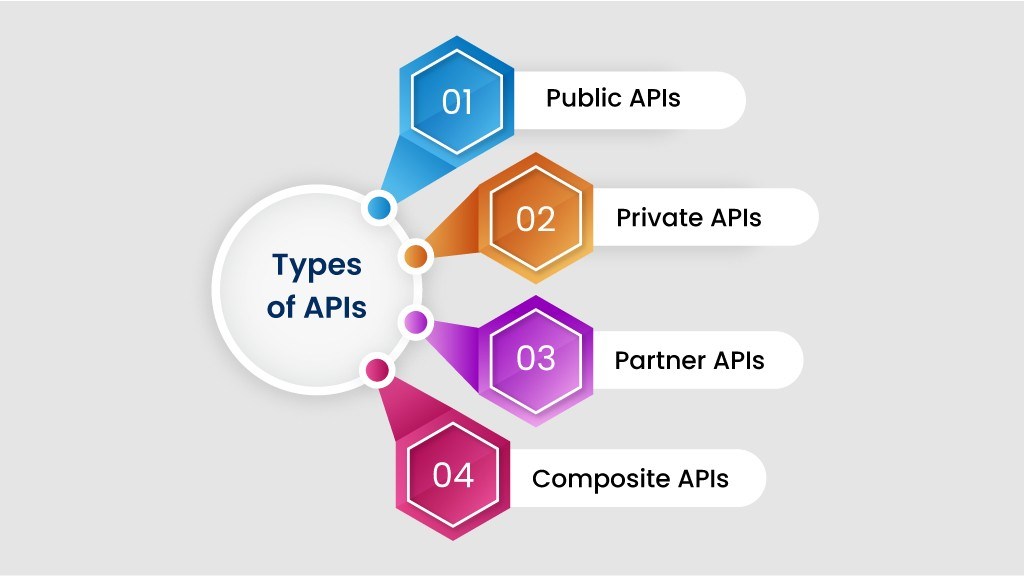In today's interconnected world, Application Programming Interfaces (APIs) play a crucial role in enabling different software systems to communicate and interact with each other. APIs define the rules and protocols for building and interacting with software applications. There are different types of APIs based on their functionality, access permissions, and architecture. In this article, we'll explore the major types of APIs and how they are used in various scenarios.
Open APIs (Public APIs)
Definition:
Open APIs, also known as External APIs or Public APIs, are designed to be accessible by any developer or system. These APIs are publicly available for external users (developers at large) and are usually free to use or come with some usage limitations.

Characteristics:
- Publicly available.
- Can be used by any third-party application.
- Typically used to allow third-party developers to access data or functionality from a service.
Examples:
- Twitter API: Allows developers to integrate Twitter’s features into other applications.
- Google Maps API: Enables developers to embed Google Maps and location services into websites or apps.
Use Cases:
- Integrating third-party services into your application (e.g., payment gateways, social media sharing).
- Allowing developers to extend functionality in various applications or platforms.
Internal APIs (Private APIs)
Definition:
Internal APIs, also known as Private APIs, are used within an organization. These APIs are not exposed to external developers but are used for communication between different systems or services within the organization.
Characteristics:
- Used internally within the organization.
- Not available for public access.
- Help different internal teams or services to communicate and share resources.
Examples:
- An internal API for managing employee data in an HR system.
- API used between an eCommerce platform’s backend services for processing payments.
Use Cases:
- Streamlining internal operations.
- Facilitating communication between different software systems within an organization.
Partner APIs
Definition:
Partner APIs are designed to be used by a specific group of developers or business partners. These APIs are shared with partners, usually via a third-party gateway or specific access credentials.
Characteristics:
- Available to select external partners.
- Often come with stricter access controls than Open APIs.
- Typically involve a contractual relationship for access.
Examples:
- A payment processor like PayPal providing API access to approved merchants.
- An API for integrating with a specific partner network or service like Amazon's affiliate program.
Use Cases:
- Offering services to business partners while maintaining control and security.
- Sharing functionalities with trusted parties without exposing it to the general public.
Composite APIs
Definition:
Composite APIs allow developers to access multiple endpoints in one call. These APIs are especially useful when a user needs information from several sources, which could be part of a single service or multiple services.
Characteristics:
- Can access multiple endpoints with a single request.
- Often used when different services or resources are needed for a single task.
- Can be a combination of different REST, SOAP, or GraphQL APIs.
Examples:
- A composite API in a travel booking platform that pulls data from flight, hotel, and car rental APIs simultaneously.
- An API that retrieves different pieces of user data from various microservices in a microservices architecture.
Use Cases:
- Optimizing performance by reducing the number of API calls.
- Simplifying workflows that require data from multiple services.
RESTful APIs (Representational State Transfer)
Definition:
RESTful APIs are a type of web service based on the principles of REST. REST is an architectural style for designing networked applications, and RESTful APIs follow these principles by using standard HTTP methods like GET, POST, PUT, and DELETE.

Characteristics:
- Stateless: Each request from a client contains all the information the server needs to fulfill the request.
- Cacheable: Responses can be explicitly marked as cacheable or non-cacheable.
- Uses standard HTTP methods (GET, POST, PUT, DELETE).
- Designed for scalability and easy integration with web-based services.
Examples:
- APIs that power websites and mobile apps, such as those for eCommerce, social media, or financial transactions.
Use Cases:
- Providing scalable and easy-to-consume web services.
- Web and mobile applications that require seamless integration and real-time interaction.
SOAP APIs (Simple Object Access Protocol)
Definition:
SOAP APIs are based on the SOAP protocol, which is a standard messaging protocol used for exchanging structured information in a decentralized, distributed environment. SOAP APIs are known for their strict rules and heavier data structures compared to REST.

Characteristics:
- Uses XML as the message format.
- Supports only specific messaging protocols (usually HTTP or SMTP).
- Has strict security standards like WS-Security.
- Ideal for enterprise-level applications that require high security and transaction reliability.
Examples:
- SOAP APIs in financial or telecommunications systems, where transactions need to be secure and reliable.
Use Cases:
- Enterprise applications requiring strong security and ACID-compliant transactions.
- Systems that need formal contracts (WSDL) for interaction.
GraphQL APIs
Definition:
GraphQL is a query language for APIs and a runtime for executing those queries. It provides a more flexible alternative to REST by allowing clients to request only the specific data they need.

Characteristics:
- Allows clients to request only the data they need, reducing over-fetching.
- Supports real-time updates via subscriptions.
- Uses a single endpoint for all interactions, unlike RESTful APIs which use multiple endpoints.
- Offers strong typing with schemas.
Examples:
- APIs for complex applications like Facebook, where users can query specific data in a flexible manner.
Use Cases:
- Reducing the number of requests made by clients.
- Handling complex data relationships in a flexible way (e.g., nested data, real-time subscriptions).
WebSocket APIs
Definition:
WebSocket APIs provide full-duplex communication channels over a single TCP connection. They are ideal for real-time applications that need instant communication between clients and servers.

Characteristics:
- Provides real-time, bidirectional communication.
- Uses a persistent connection, allowing for continuous data exchange.
- Typically used for applications like gaming, chats, and live updates.
Examples:
- WebSocket APIs are used in applications such as live stock market feeds, real-time multiplayer games, and collaborative tools.
Use Cases:
- Real-time applications where continuous data flow is required.
- Use cases that require low-latency communication, such as financial trading platforms.
Conclusion
APIs are the backbone of modern software development, enabling diverse systems and platforms to interact efficiently. Understanding the different types of APIs—whether open, internal, partner, composite, or specific to a protocol like REST, SOAP, GraphQL, or WebSocket—allows developers to choose the right type for their use case, ensuring smooth communication and integration.
By choosing the appropriate API type, businesses can create more efficient, scalable, and secure applications, providing a seamless experience for users while meeting the unique needs of their platforms.




Leave Comment